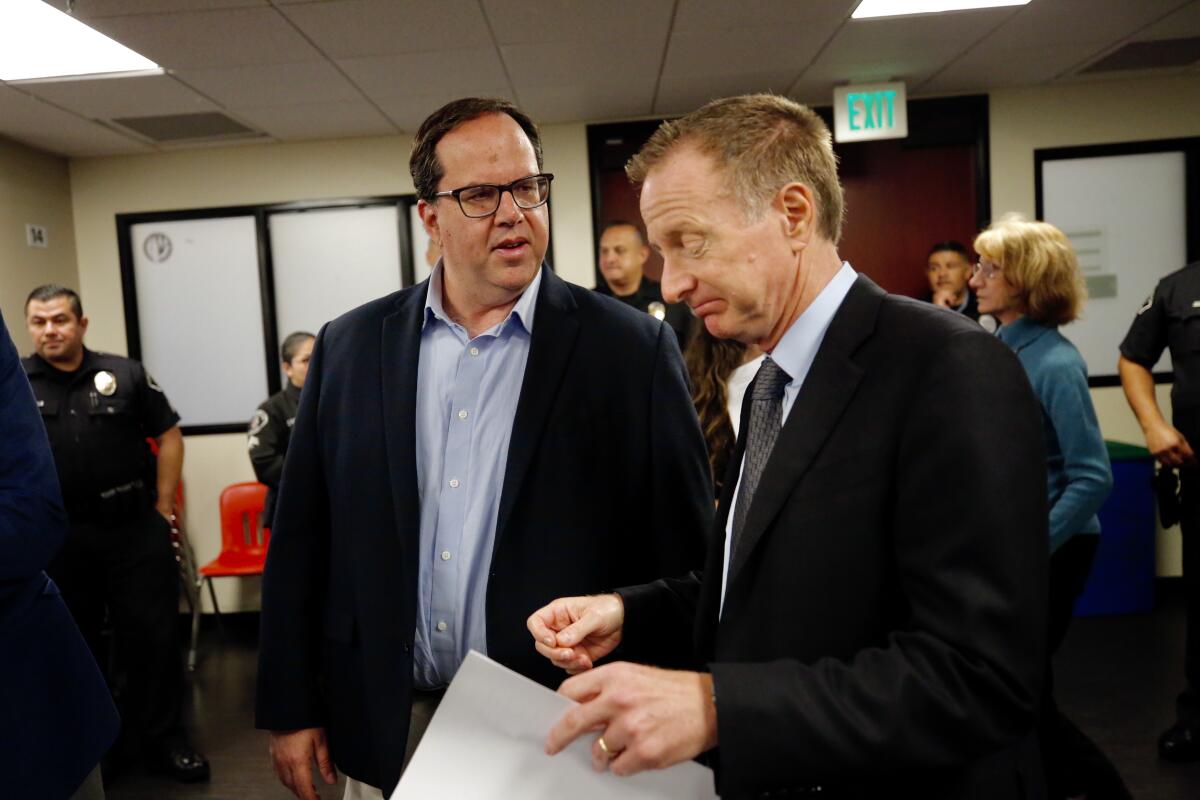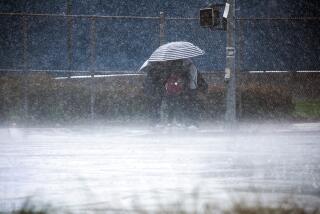L.A. Unified won’t open family resource centers, citing coronavirus health risk

- Share via
Los Angeles school officials have halted a plan to open 40 family resource centers due to increasing concerns over the spread of the coronavirus.
The 40 planned centers were intended as a service point and refuge for students and families in need of food, childcare, counseling and educational materials. Instead, 60 grab-and-go food centers will be available for school families.
“At this time, state and local health and public safety officials cannot assure us it will be safe for the children and adults at the family centers for us to provide care for children at these sites,” said Supt. Austin Beutner in a letter posted on social media Monday afternoon. “We are deeply disappointed.”
The decision was made amid rapidly changing guidance and restrictions from health agencies and other levels of government. For example, over the course of several hours on Sunday, restaurateurs went from no restrictions, to reduced capacity statewide, to an L.A. ban on dining in.
As Beutner weighed the decision earlier Monday he cautioned that the “more fundamental issue is making sure we can do it safely.”
Los Angeles Unified, which serves about 670,000 children and adults, shut down its 900 campuses beginning Monday morning, joining closures at 24 of the state’s 25 largest school systems. More than half of California’s school districts have shut down, accounting for about 85% of students.
The centers seemed like an ambitious but sensible solution for parents desperate for childcare and other resources. These parents include first responders, such as ambulance drivers and healthcare workers. In this health siege, key personnel also include pharmacists and supermarket checkers.
At the centers, visitors would have had their temperature taken on the way in and would immediately wash their hands. A district operations planner said that lines for food or other services would be set up so people were standing six feet apart. The centers were to be open from about 6:30 a.m. to 6:30 p.m.
But ultimately, if schools are closed because of concerns over transmission of the coronavirus, should a resource center be treated any differently?
“We’re trying to make sure we’re doing the right thing,” Beutner said earlier Monday.
Even in the best scenario, families were on their own until Wednesday.
Monday morning, Julia Andres sat quietly on a green metal bench with her two school-aged sons as they waited for a city shuttle in MacArthur Park. The trio were heading to Andres’ job at a garment warehouse in downtown Los Angeles because she can’t afford daycare.
“I have to bring them to work,” she said. “I have to try and work whatever hours I can get.”
Tugging on his older brother’s hand, 10-year-old Miguel Petz, a fourth-grader at Vermont Elementary School, said he was worried about his parents being infected by the virus.
“I’m scared about it,” he said.
Miguel said he had a packet for homework that he would be working on, and that he would do other courses online using his older brother’s Chromebook.
Emmanuel Garcia, 13, a 7th-grader at Foshay Learning Center, said he was going to do most of his courses online, some through Schoology, an LAUSD online learning system.
His feelings are mixed about schools being closed.
“We’re out of school,” he said. “But then we have homework.”
Even for families with greater flexibility, the options are limited with libraries, museums, recreation centers and other gathering places closed.
The district faced an additional challenge late Sunday when a false fire alarm in a key data center triggered the release of retardant that shut down the critical system for about 12 hours, just as thousands of students and teachers were supposed to login for instruction, according to school district officials.
The system that powers the online platform was reportedly back up by about 8:30 a.m. During the outage, students and teachers were not able to communicate.
Beutner said he got an urgent text about a problem between 10 and 11 p.m. Sunday night. He could not respond instantly because he was on an unrelated urgent call.
He ended up being awake most of the night “but not just because of that,” he said.
“Late last night we called in another 30 people who worked through the night,” he said. “We’re appreciative of their efforts to get the system going.”
Beutner said he did not yet have a cost estimate for the damage.
During the shutdown, teachers are expected to do what they can to keep learning going via online and electronic coursework and even old-fashioned paper homework packets. Other staff are tasked with keeping schools secure and sanitized. And principals stood by Monday morning to alert parents who didn’t get the message that campuses are closed. Also, students who were absent Friday could stop by in the morning to pick up assignments, instructional materials and possibly computers.
School board president Richard Vladovic said that he drove by 10 schools Monday morning and saw only four students total entering a campus.
Gov. Gavin Newsom on Sunday reiterated his position that he would not — for now — mandate the shuttering of all schools in the state.
West Covina Unified wasn’t ready to close Friday but announced an immediate shutdown Sunday after an “individual,” as the district put it, at West Covina High School tested positive for COVID-19. It was not immediately clear whether the affected person was a staff member, student, family member or volunteer.
The immediate plight for families did not get easier Sunday night after L.A. Mayor Eric Garcetti took additional precautionary measures. The city’s public libraries and indoor recreation centers are closed — cutting off more activities and child-supervision options. Major museums are shut, including the L.A. County Natural History Museum, the La Brea Tar Pits Museum and the L.A. County Museum of Art.
While Newsom ordered the closing of nightclubs, bars and brew pubs, Garcetti went further, banning all dining in. Restaurants still can offer take-out service. That ban further narrows student and family options — including the use of restaurant WiFi for families without broadband at home. A library, coffee house or McDonald’s often become a place where low-income students and families have WiFi access.
Beutner has estimated that about a quarter of students lack the broadband needed for effective online study.
Many also lack for nutritious, abundant food — about 80% of L.A. students qualify for a free or reduced price lunch. And many rely on the district for breakfast. Some take advantage of free dinners as well. About 18,000 district students are homeless.
“Los Angeles Unified serves a high-needs population, and our schools provide a social safety net for children,” Beutner said Friday. “The closing of any school has real consequences beyond the loss of instructional time.”
Times staff writers Sonali Kohli and Ruben Vives contributed to this report.
More to Read
Sign up for Essential California
The most important California stories and recommendations in your inbox every morning.
You may occasionally receive promotional content from the Los Angeles Times.














